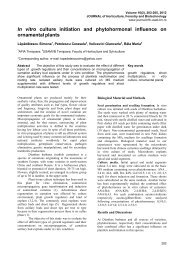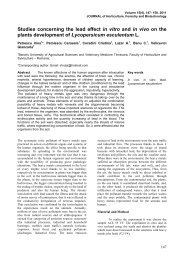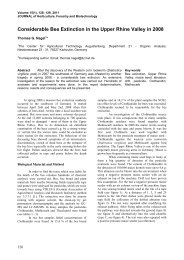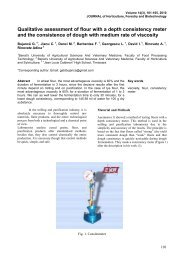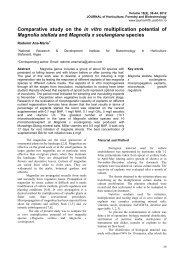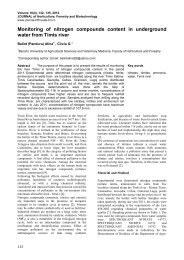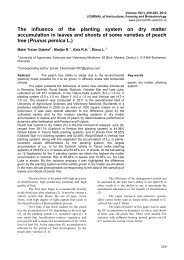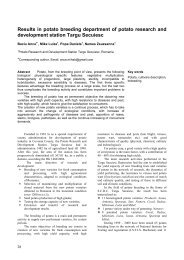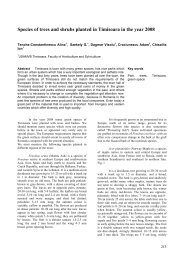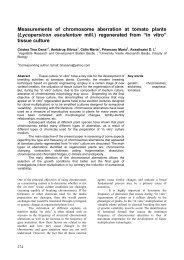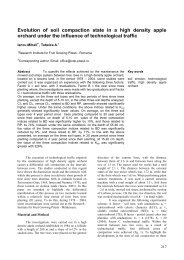Endophytic fungi from Vitis vinifera L. isolated in Canary Islands and ...
Endophytic fungi from Vitis vinifera L. isolated in Canary Islands and ...
Endophytic fungi from Vitis vinifera L. isolated in Canary Islands and ...
You also want an ePaper? Increase the reach of your titles
YUMPU automatically turns print PDFs into web optimized ePapers that Google loves.
Aspects regard<strong>in</strong>g the physiology of cuscuta (Cuscuta L.Convolvulaceae)Tănase Maria 1 *, S<strong>and</strong> Camelia 11 “Lucian Blaga” University of Sibiu*Correspond<strong>in</strong>g author. Email: maritanase@yahoo.comAbstract Many species of Cuscuta conta<strong>in</strong> a small amount of chlorophyll;<strong>and</strong> while both chlorophyll a <strong>and</strong> b are present <strong>in</strong> normal proportions, theyonly occur <strong>in</strong> a very low concentration. Several authors have demonstratedthe capacity of Cuscuta for photosynthesis, mak<strong>in</strong>g use of CO2 14 . Fer hasdemonstrated that Cuscuta exposed to strong air illum<strong>in</strong>ation, with a CO 2concentration much higher than the normal atmospheric CO 2 concentration,fixes more CO 2 dur<strong>in</strong>g the photosynthesis process than the amount producedby means of respiration <strong>in</strong> both <strong>in</strong>dependently liv<strong>in</strong>g seedl<strong>in</strong>gs <strong>and</strong> <strong>in</strong> the stemexcised <strong>from</strong> the host.The migration of assimilates is only occurr<strong>in</strong>g acropetally, notonly <strong>in</strong> the case of the plantula, but also <strong>in</strong> the case of the mature parasite.The entirely acropetal migration of assimilates can be expla<strong>in</strong>ed by theattract<strong>in</strong>g effect exerted by the term<strong>in</strong>al sprout, as well as by the lateralsprouts situated on the subterm<strong>in</strong>al part of the branch. The rudimentary rootof the plantula does not have a meristem [19]; [12]; [28]; [23]; <strong>and</strong> theabsence of a downward migration with<strong>in</strong> the plantula thus appear<strong>in</strong>g to bedeterm<strong>in</strong>ed by the absence of the radicular meristem [9].Key wordsCuscutasp.,photosynthesis, chlorophylla <strong>and</strong> b, assimilatetransportResearch on the spread<strong>in</strong>g of cuscuta <strong>in</strong> South-EastTransylvania – RomaniaTanase Maria 1* , S<strong>and</strong> Camelia 1 , Gheorghe Maria 2 , Moise Crist<strong>in</strong>a 1 , Stanciu Mirela 1 ,Antonie Iuliana 11 University “Lucian Blaga” Sibiu; 2 Romanian Academy*Correspond<strong>in</strong>g author. Email: maritanase@yahoo.comAbstract Cuscuta (dodder) species are holoparasitic anthophytes, almostentirely deprived of roots, but hav<strong>in</strong>g filamentary stems; <strong>and</strong> attack<strong>in</strong>gnumerous host plants, on which they fix themselves by means of haustoria.The economic losses determ<strong>in</strong>ed by the presence of the dodder are ratherdifficult to support by develop<strong>in</strong>g countries, especially by those which are <strong>in</strong>need of agricultural development. In the region on which the research hasbeen carried out, the most common species occurr<strong>in</strong>g <strong>in</strong> grassl<strong>and</strong>s <strong>and</strong>perennial legum<strong>in</strong>ous forages have been: Cuscuta campestris (Yuncker),Cuscuta epithymum (Murray (L.) Noth.) <strong>and</strong> Cuscuta trifolii (Bab<strong>in</strong>gton). Thepresence of Cuscuta on cultures can cause substantial damages not only <strong>in</strong>our country, but <strong>in</strong> all countries with a warm <strong>and</strong> temperate climate, <strong>in</strong> which itis regarded as a quarant<strong>in</strong>e parasite. [5]The Cuscuta species have developed certa<strong>in</strong> means of adaptation <strong>in</strong>order to <strong>in</strong>crease their rate of success: a late seed germ<strong>in</strong>ation, when hostplantsare relatively well-developed; a rather high degree of <strong>in</strong>dependencewhich can ensure its survival dur<strong>in</strong>g a quite long period of autotrophic life(maximum of one month); the <strong>in</strong>vasion of the host plant by extremelyelaborated <strong>and</strong> complicated means, etc. Cuscuta dissem<strong>in</strong>ates to a largeKey wordsCuscuta sp,. host plants,quarant<strong>in</strong>e parasite,spread<strong>in</strong>g



